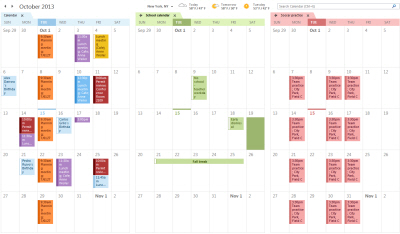Dynamic Distribution Groups in Exchange Online

If just a few days ago i explained how to create and manage Distribution Groups under Exchange Online, now i come to do the same about Dynamic Distribution Groups under Exchange Online.
Definition and Functionality
Dynamic Distribution Groups are a functionality that allows to receive E-Mails under a virtual address and distribute them between their members, defining members to be the ones that meet one or more of the conditions we specify under the properties of the group according to values of the user properties.
An example of this would be a department like Office365 IT Support located at NY with one or more employees that have the need of forwarding all the E-mails sent to an address like o365.support.NY@contoso.com. Due that this department has fluent employees that come and go out of the company, it’s management could be more loaded than expected. To avoid this, Microsoft thought of a new functionality that could automatically add members located at the NY office and the Office365 IT support department.
With this functionality we will not only avoid configuring a POP account PC by PC, but also be able to assign permissions to users who want to send E-mails as the department address or on behalf of in difference to the Distribution Groups of other platforms, and also avoid high workload on the management area as it’s automatic.
Configuration through the Office365 Portal
– The first thing we have to do is access our Office365 portal (http://portal.microsoftonline.com). – Then we need to access the Exchange Control Panel or ECP clicking on the upper side of the screen where it says «Admin» and then on «Exchange». (Click here to access the ECP if you have a Small Business Plan).
– Once inside, click on «Groups».
– Click on the «+» Symbol and then where it says «Dynamic Distribution Group» – Set the properties of the group we want to create:
Display Name: this is the name it will appear on the Global Address List and also on the recipients as the Department.
Alias: this field is the identifier that the system will use to localize and identify this group.
Description: we can assign a short description of the use we’ll use the group for.
Owners: indicates who will have the permissions to make modifications over this group.
Members: here we will define who will form part of this group, allowing to receive all the messages sent to the virtual address, only if they meet the conditions we set below.
– Once you’ve created the group, we can define additional properties doing a double click on it.
The screens we will find are:
General, where we can define or edit options like Display Name, the SMTP address it will use, Description and something very important, the ability to hide the group from the Global Address List (GAL).
Ownership, where we can set the owners that can make modifications to the group, including the new member approvals.
Membership, here we can set the members or recipients of the mails sent to the virtual address and the conditions they have to meet to be one of it.
Membership Approval, to set the permissions config to join or leave the group.
Delivery Management, where we can set the senders that can send messages to this group. By default the selected option is set to «Only senders inside the organization», so if we want to receive messages from outside the organization we must select the other option where it says «Senders inside and outside of my organization». Also we can set specific members that can send to this group.
Message Approval, here we can set the message flow to moderate the messages in case we want to approve the received messages before distributing it to its members. We can also define the moderators we want and if we want to exclude from this rule certain senders in who we trust. Also have the possibility to notify the sender in case his message has been rejected.
E-mail Options, from this section we can define one or various SMTP addresses to be used to receive using this group.
Mailtip, we can also define the message that will appear to users inside our organization using Microsoft Outlook when selecting the group as recipient. For example a message indicating it can be a delay of two days for answering the message.
Group Delegation, here we can assign permissions to «Send As» or «Send on Behalf Of» to users so they can send messages using the group as the sender.
Configuration through PowerShell
– First of all we need to prepare our environment to connect with our Office365 subscription via PowerShell.
– Then we only need to run the following:
New-DynamicDistributionGroup -Name «Dynamic DG Name» -RecipientFilter {(RecipientType -eq ‘UserMailbox’) -and (Department –like <DeptName’>)}
– Set the group to allow messages to be received from outside and inside the org:
Set-DynamicDistributionGroup «Group Name» -RequireSenderAuthenticationEnabled $False
– Assign other owners of the group:
Set-DynamicDistributionGroup -Identity «Group Name» –ManagedBy user@company.com -BypassSecurityGroupManagerCheck
– Add additional SMTP addresses to the group:
Set-DynamicDistributionGroup «Group Name» -EmailAddresses SMTP: dept@company.com, alias@company.com
– Hide the group from the Global Address List (GAL):
Set-DynamicDistributionGroup «Group Name» -HiddenFromAddressListsEnabled $True
– Show members of a Dynamic Distribution Group:
$DDG = Get-DynamicDistributionGroup «Dynamic DG Name» Get-Recipient -RecipientPreviewFilter $DDG.RecipientFilter |ft alias
I hope you find this useful.

















